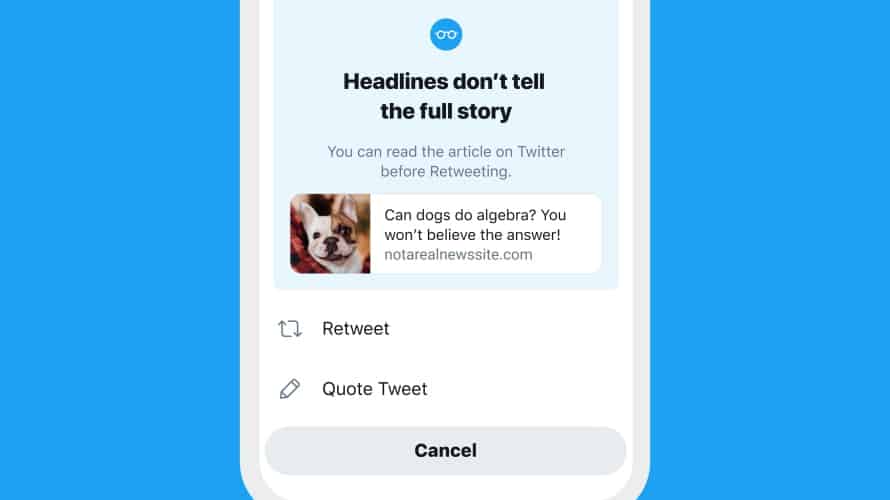Twitter to Prompt Users to Read Articles Before Sharing
The feature is designed to curb the spread of fake news and promote informed tweeting
- Last Updated Sep 25, 2020

Since June, Twitter has been testing a feature which gives users a prompt before attempting to retweet an article they haven’t read, encouraging them to read first, in an attempt to curb the spread of misinformation. The prompt reads: “Headlines don’t read the full story. You can read the article on Twitter before you retweet it.” It doesn’t stop users from retweeting the article at all, but just gives a gentle nudge to make sure they’re informed on what exactly you’re sharing.
Sharing an article can spark conversation, so you may want to read it before you Tweet it.
To help promote informed discussion, we're testing a new prompt on Android –– when you Retweet an article that you haven't opened on Twitter, we may ask if you'd like to open it first.
— Twitter Support (@TwitterSupport) June 10, 2020
Twitter’s motivation for this is to “help promote informed discussion” and, according to their test results, it seems to be working.
When it comes to sharing news online, approximately 80% of people don’t look past the headline before clicking the retweet button. That means that only two out of 10 people will actually read the contents of a news article before making sure other people get to know about it, too.
To some, this might seem reasonable. If you’re short on time, you can’t always commit to reading a full story and, besides, headlines are meant to be the most important aspect of the story condensed into one line, right? Wrong. The predominant purpose of headlines is to bring attention to a story, to draw a reader in. Overwhelmingly now, as the majority of people get their news online, the purpose of the headline is to generate clicks. On a fast-moving site like Twitter, that headline has to be shocking enough to entice people to open the full article – after all, clicks create revenue for most digital news outlets.
This means that headlines can be extremely misleading and sharing news articles without getting the full story is a big reason for the circulation of fake news – something that is becoming increasingly hard to deal with.
Twitter has a solution, though, and it’s getting ready to implement it globally after a few more tests.
After testing the new feature on a limited number of Android users, Twitter found that people are 40% more likely to read an article if they receive the prompt and people opening articles before retweeting increased by 33%, meaning people were making more informed decisions about what they were tweeting about.
They also found that some people didn’t retweet the article after reading it – “some things are better left in drafts,” Twitter said – which is absolutely the point of this prompt and makes a great point about how misleading headlines can actually be.
📰 More reading – people open articles 40% more often after seeing the prompt
📰 More informed Tweeting – people opening articles before RTing increased by 33%
📰 Some people didn’t end up RTing after opening the article – which is fine! Some Tweets are
best left in drafts 😏— Twitter Comms (@TwitterComms) September 24, 2020
Next steps include rolling out the feature globally, after a few updates – once you’ve seen the prompt for the first time, Twitter plans to make it a little less confronting by making it smaller (“we get that you get it”).
The Verge seemed to make a rather critical point regarding the feature, stating “Hopefully all this experimentation is just a warm-up for the next logical step: a warning shown to all users before they tweet anything at all,” but, sarcasm aside, are they wrong? Twitter is a quickfire platform and I couldn’t count the amount of times I’ve gone back to delete a tweet or un-retweet someone else’s over the years.
Besides, Twitter users seem to be happy with the update, with one user calling it a “wonderful change” and another applauding Twitter for “doing the good work.”
Please keep this, that's a wonderful change.
— Ryan Brown 🎮 (@Toadsanime) September 24, 2020
twitter comms out here doing the good work. 👏🏾👏🏾
— jayde i. powell (@jaydeipowell) September 24, 2020
One user asked Twitter to do the same for replies. Lucky for them, the company has been testing out another feature prompting users to take a moment before sending an offensive reply, too.
